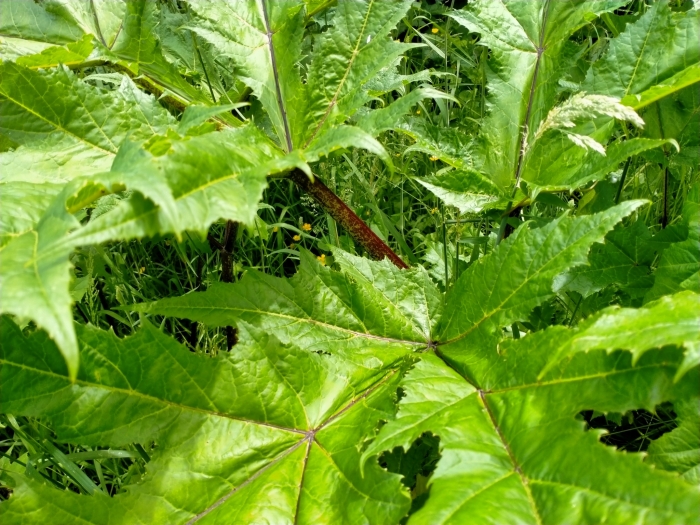Giant Hogweed
(Heracleum mantegazzianum)
Giant Hogweed (Heracleum mantegazzianum)
/
/

John Barkla
CC BY 4.0
Image By:
John Barkla
Recorded By:
Copyright:
CC BY 4.0
Copyright Notice:
Photo by: John Barkla | License Type: CC BY 4.0 | License URL: http://creativecommons.org/licenses/by/4.0/ | Rights Holder: John Barkla | Publisher: iNaturalist | Date Created: 2021-12-02T14:52:38-08:00 |

























Estimated Native Range
Summary
Heracleum mantegazzianum, commonly known as Giant Hogweed, is a monocarpic perennial herb native to the western Caucasus region of Eurasia and found in river valleys, mountainous regions, and open woodlands. It can grow up to 16 feet tall with deeply lobed leaves that can span up to 5 feet in width. The plant has a stout, green stem with dark reddish-purple spots. During its flowering season, typically from late spring to midsummer, it produces large, umbrella-shaped white flower clusters that can be up to 2.5 feet in diameter and are quite showy. After flowering and setting seed, the plant typically dies.
Giant Hogweed is known for its phototoxic sap, which, upon contact with skin and exposure to sunlight, causes severe skin inflammation and blistering—a condition known as phytophotodermatitis. Due to its invasive nature, it is not recommended for cultivation and is considered a noxious weed in many regions. It is important for gardeners to handle this plant with extreme care and to wear protective clothing if managing existing populations. In terms of cultivation, it prefers moist soil conditions and can thrive in both full sun and partial shade. However, due to its invasive potential and the dangers posed by its sap, it is generally discouraged from being planted.CC BY-SA 4.0
Giant Hogweed is known for its phototoxic sap, which, upon contact with skin and exposure to sunlight, causes severe skin inflammation and blistering—a condition known as phytophotodermatitis. Due to its invasive nature, it is not recommended for cultivation and is considered a noxious weed in many regions. It is important for gardeners to handle this plant with extreme care and to wear protective clothing if managing existing populations. In terms of cultivation, it prefers moist soil conditions and can thrive in both full sun and partial shade. However, due to its invasive potential and the dangers posed by its sap, it is generally discouraged from being planted.CC BY-SA 4.0
Plant Description
- Plant Type: Herb
- Height: 7-20 feet
- Width: 5-10 feet
- Growth Rate: Rapid
- Flower Color: White
- Flowering Season: Spring, Summer
- Leaf Retention: Deciduous
Growth Requirements
- Sun: Full Sun, Part Shade
- Water: Medium
- Drainage: Medium, Slow
Common Uses
Erosion Control
Natural Habitat
Native to river valleys, mountainous regions, and open woodlands in the western Caucasus region
Other Names
Common Names: Giant Hogweed , Wild Rhubarb , Herkulesstaude , Hogweed
Scientific Names: Heracleum mantegazzianum , Heracleum circassicum , Heracleum grossheimii , Heracleum mantegazzianum f. rosicalyx , Heracleum mantegazzianum var. immaculatum , Heracleum montegazzianum , Heracleum speciosum , Pastinaca mantegazziana
GBIF Accepted Name: